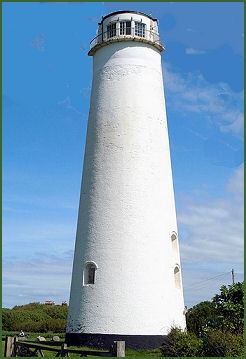Leasowe
OS Grid ref:-
 The town of Leasowe is situated at on the north coast of the Wirral peninsula. The name derives from the Anglo-Saxon Leasowes or 'Meadow Pastures'.
The town of Leasowe is situated at on the north coast of the Wirral peninsula. The name derives from the Anglo-Saxon Leasowes or 'Meadow Pastures'.
Leasowe's sand dunes are the largest such system on the Wirral. Much of the area is at or below sea level and is protected by the coastal embankment.
Leasowe Castle was built in 1593 by Ferdinando Stanley, 5th Earl of Derby, a patron of Will Shakespeare, possibly (though this is disputed) as an observation platform for the Wallasey races which took place on the sands in the sixteenth and seventeenth centuries, and which are regarded as a forerunner of the Derby races. Ferdinando's brother William, the 6th Earl, was described as a noted sportsman and is remembered as a keen supporter of the Wallasey races.
At first the castle consisted only of an octagonal tower. This had become disused by 1700, and it became known as "Mockbeggar Hall", a term often used for an ornate but derelict building. The term "Mockbeggar Wharf" is still used for the adjoining foreshore.
 The castle passed to the Cust family in 1821. After 1826 the building was used as a hotel for some years. The ceiling of the Star Chamber at the Palace of Westminster was brought to the castle in 1836 along with panelling and other furnishings after the old exchequer buildings were demolished. The Star Chamber was so called because the ceiling was decorated with bright stars. The ceiling and four tapestries depicting the four seasons still remain. Oak panelling from the Star Chamber and some made from the submerged forest along the coast were also installed. However the oak panels were removed in 1893. Between 1911 and 1970, it became a railway convalescent home, and between 1974 and 1980 it was owned by Wirral Borough Council. It then became a hotel again, and was acquired by Lawton Hotels Ltd in 2000. The hotel is now a popular venue for weddings and other family functions, with around 50 bedrooms.
The castle passed to the Cust family in 1821. After 1826 the building was used as a hotel for some years. The ceiling of the Star Chamber at the Palace of Westminster was brought to the castle in 1836 along with panelling and other furnishings after the old exchequer buildings were demolished. The Star Chamber was so called because the ceiling was decorated with bright stars. The ceiling and four tapestries depicting the four seasons still remain. Oak panelling from the Star Chamber and some made from the submerged forest along the coast were also installed. However the oak panels were removed in 1893. Between 1911 and 1970, it became a railway convalescent home, and between 1974 and 1980 it was owned by Wirral Borough Council. It then became a hotel again, and was acquired by Lawton Hotels Ltd in 2000. The hotel is now a popular venue for weddings and other family functions, with around 50 bedrooms.
Leasowe Lighthouse is the oldest brick built lighthouse in the United Kingdom. Constructed of hand made brick in 1763 by the Mersey Docks and Harbour Board, it rises to one hundred and one feet (27 metres) in height, and stands on the sand dunes at Leasowe Common, between Moreton and Wallasey. There are seven floors which can be reached by means of a cast iron spiral staircase of 130 steps.
. The lighthouse was one of four on the North Wirral Foreshore, used to guide ships into the entrance to the Rock Channel and the port of Liverpool. The others consisted of two at Hoylake and another, a lower light, at Leasowe. The latter, which was situated a quarter of a mile (0.4km) out to sea, was destroyed by a storm and was replaced by a lighthouse on Bidston Hill in 1771.
Nearby places of interest
The National Waterways Museum at Ellesmere Port, is situated at the northern end of the Shropshire Union Canal where it enters the Manchester Ship Canal. It contains the largest collection of canal boats in the world. With its fascinating displays housed in a fine collection of Victorian buildings, the museum makes a great day out whatever the weather.
The Blue Planet Aquarium at Ellesmere Port is the largest aquarium in the UK, and boasts two floors of interactive displays and exhibits. The Blue Planet holds more sharks than anywhere else in Britain, holding more than ten different species from around the world including sand tiger sharks.
Brotherton Park, a nature reserve, is a one of the finest examples of ancient woodland on the Wirral and once formed part of the Royal forest of Wirral dating back to the end of the last ice age. Other habitats on the reserve include wildflower meadows, reed swamps and historic parkland. Brotherton Park and Dibbinsdale comprises of 47 hectares of semi-natural countryside along the valley of the River Dibbin.
Eastham Country Park is situated on the banks of the River Mersey, the park covers a hundred acres and contains some of the finest mature trees to be found on the Wirral. The park offers excellent views across the estuary and the cliffs at provide superb sites for viewing the flocks of waders and ducks on the estuary. Much of the Estuary is now designated a Site of Special Scientific Interest.
